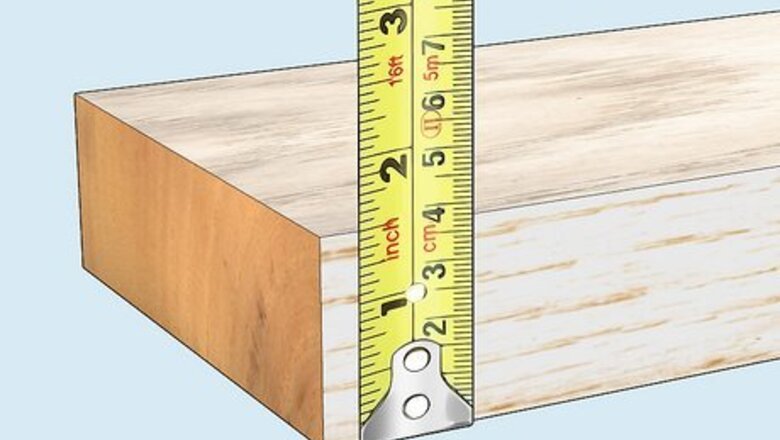
views
Adjusting the Kreg Jig for Your Project
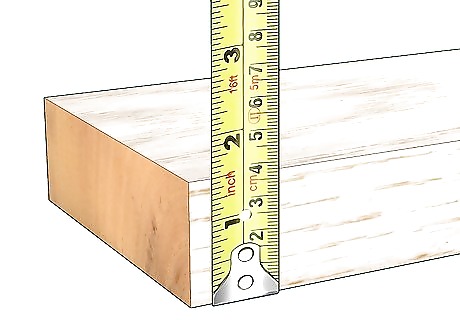
Measure the wood you’re using. Before you begin drilling, it’s important to measure the width of the boards you’ll be working with. The thickness is what you’re looking to gauge here. Knowing the exact thickness of the board will enable you to drill the pocket holes at just the right angle. Always measure your wood, regardless of the specifications given on the label. It’s possible for wood to shrink or for a board’s width to be based on averages rather than precise measurements. The difference of a fraction of an inch could potentially throw off your whole project.

Set your drill bit collar to the correct depth. Line the pocket hole drill bit up with the specifications indicated on the base of the jig. The step (the place on the bit where it narrows to a point) should be even with the notch that corresponds to the thickness of your board. Slide the depth collar to the appropriate height and tighten it using an Allen wrench. The depth collar is slightly wider than the guide holes of the jig, and will keep you from drilling too far into the wood. A special pocket hole drill bit should be included with your new Kreg Jig.
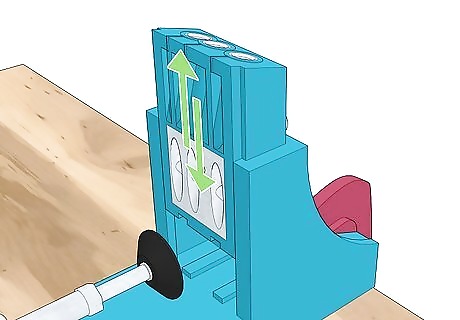
Change the placement of the jig. Using the same measurements, adjust the height of the jig to the appropriate position. To do this, loosen the thumbscrew on the back so that you can raise or lower guide hole piece freely. Once the jig is where you want it, tighten the thumbscrew to secure it. Raising and lowering the jig will change the angle of the guide holes slightly to make them suitable for boards of varying widths. Remember to reset the guide hole piece every time you drill a board of a different size.
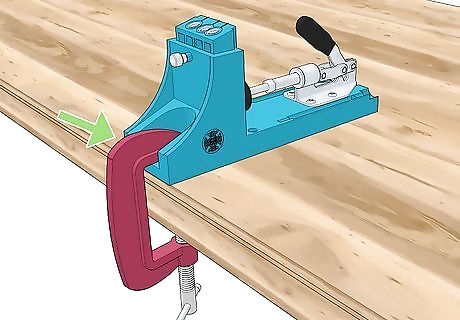
Secure the jig to the workbench. Clamp the jig down so that it will remain firmly in place. This will prevent the wood from coming loose while you’re drilling. Make sure the guide holes of the jig are facing toward you on the workbench. You’ll be drilling into the back side of the board, which won’t be visible once the piece is completed.
Drilling the Pocket Holes
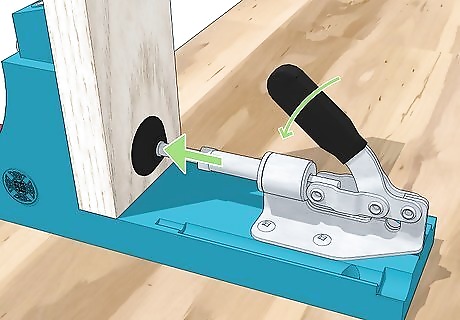
Clamp the wood into the jig. Place one end of the wooden board vertically against the clamp backing on the opposite side of the jig, then pull the lever to press the clamp tight against it. Test the board to make sure that it doesn’t slide around. The clamp lever should lock into position once the clamp is fully extended.
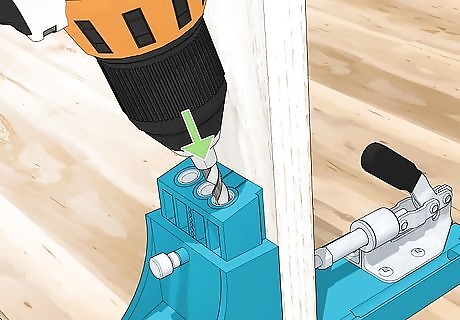
Fit the drill bit into the guide holes in the jig. The guide holes should be just large enough to comfortably accommodate the drill bit. Most standard Kreg Jig models will have at least three guide holes so that you can drill as many holes as needed to support the joint. For greater precision and security, keep your pocket holes spaced at even distances. Should you need more pocket holes than your jig allows, you can make room for more by shifting the wood down in the clamp after drilling your first set.
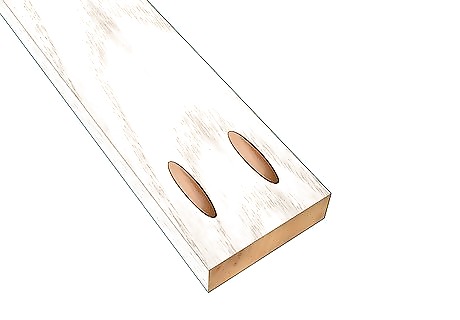
Drill the desired number of pocket holes. Begin drilling into the guide holes using steady pressure until you’re stopped by the depth collar. Pull back on the drill as you work to free the guide holes of loose wood chips. Drill as many holes as you need to create a strong joint that will suit the purposes of your project, then turn the board around and repeat the process on the other end. Try drilling on a scrap piece of wood first to confirm that the settings on the jig are correct. You’ll need to drill at least two pocket holes—otherwise, the boards will pivot around the single screw. The jig will allow you to drill at a shallow angle into the wood, which results in a more structurally sound joint than if you were to drill straight through.
Fastening the Joint

Press the pieces of wood together to form a joint. Now that you’ve drilled the boards, arrange them the way they’ll go in the finished project. Make sure the edges are evenly aligned. If you prefer, you can clamp the boards in place to make them easier to manage. Line up the boards carefully to avoid making a costly mistake. If you’re using a smaller clamp, clamp both pieces of wood to the table at the seam.
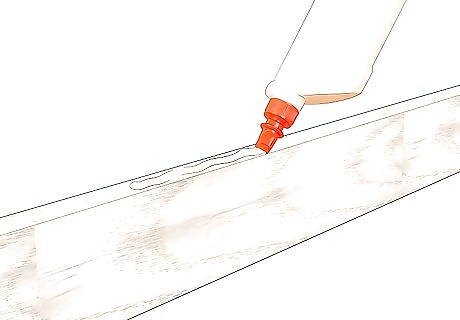
Glue the edges of the joint together for added security. Spread a thin layer of wood glue onto the edges of the boards where they connect. This will reinforce the joint even further and prevent the boards from coming apart as you fasten them. Give the glue a few minutes to set up to make the joint more sturdy while drilling. If you're using wood glue in addition to a conventional clamp, apply the glue before you align the edges of the boards.
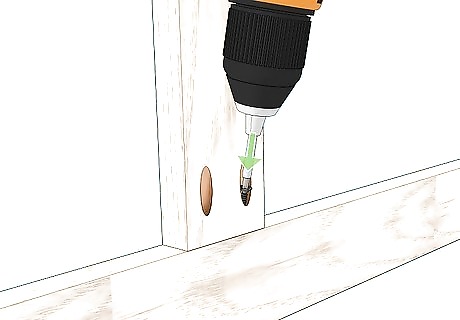
Drill the screws into place. Fit the screws into the pocket holes so that they’re aimed at the body of the adjoining board. Drive the screws deep until they disappear inside the pocket hole. The pocket hole bit conveniently bores its own thread as it drills, so you should have no problem getting the screws to hold. For softer woods, use screws with a coarse thread. Finer threads should be reserved for hard, dense varieties of wood like maple and oak. Select the right type of screw for the exact specifications and type of wood you’re using.
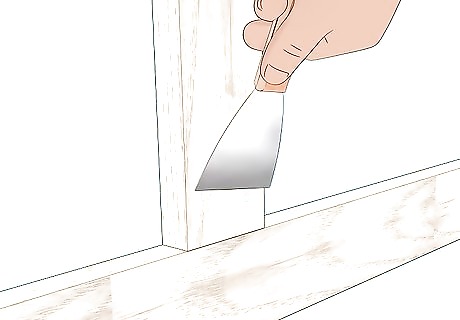
Conceal the pocket holes with wood plugs or adhesive. Once you’re done, you may notice shallow depressions left behind at the openings of the pocket holes. These can easily be filled with a glob of putty or wood glue. You could also invest in a set of Kreg wood plugs, which are specially tapered to slide right in for a smooth, seamless finish. Plugging the pocket holes is merely a cosmetic choice, and won’t affect the strength of the joint in any way. Since you’ll be drilling into the back or underside of the boards, the pocket holes on the finished piece shouldn’t be visible even if you haven’t taken steps to conceal them.




















Comments
0 comment